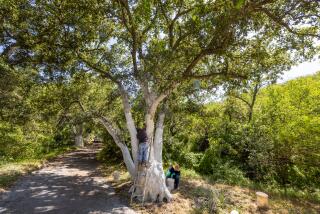Fruit Beetle Clumsy but Harmless
- Share via
Question: What I thought were just carpenter bees seem to be some kind of beetle. They have an iridescent green shell and hang out in my sycamore tree. Could I have the dreaded Japanese beetle?
--S.Z., Los Angeles
Answer: Actually these inch-long, iridescent beetles are relatives of the sacred Egyptian scarab, but our scarab is called the green fruit beetle (Cotinus mutabilis) because it nibbles on ripe fruit. Only occasionally do they cluster on fruit and do real damage; otherwise, they are seldom a pest and are uninterested in your sycamore. They are harmless but fly clumsily, sometimes running into people and startling them.
Originally native to Arizona--where they presumably fed on cactus fruit--they arrived here in the 1970s. While the beetles are pretty enough to be jewelry, the larvae are fat, white grubs about 2 inches long--at least as big and ugly as the grubs devoured recently by the contestants on television’s “Survivor.” The grubs only eat decaying vegetation and do not eat turf or roots. They are most often found in compost piles, to the disgust of queasy gardeners, but they help the composting process.
*
Q: I have heard conflicting opinions on when to water the lawn. I always heard it was best when the sun was off the lawn, as the water drops act like little magnifying glasses and can burn the grass. I typically water in the evening, but when should I?
--A.S., Westchester
A: It’s an old gardener’s tale that water droplets can burn the blades of grass. It’s simply not true. You can spritz plants in the middle of the day if you feel they need it, though they seldom do.
Watering in the evening, however, is not a good idea. A lawn that stays damp at night is susceptible to rots, molds and fungus diseases, including mushrooms. According to Scot Smalley at Pacific Sod in Camarillo, none of these will do serious damage to an established lawn, but they can kill portions of new or young lawns.
Experts agree that the time to water is early in the morning. If your sprinklers are on timers, the best time is just before the sun comes up. Early irrigation lets the surface of the lawn dry during the day, which cuts down dramatically on disease.
Smalley also points out that you shouldn’t water too often. Water about twice a week, letting the sprinklers run for 20 to 30 minutes each time for deep-rooted fescues (less for shallow Bermuda). You want water to soak far into the soil where it is safe from evaporation, and where the roots are.
This timing and duration can vary greatly--by season, location, kind of soil and the wind. But start with these times and adjust them up or down to meet your situation. You want to avoid watering every day for short periods because that encourages disease and mushrooms.
*
Q: Is there any way in which sawdust can be used in the garden or is it something that would be detrimental to the plants? Much of my husband’s collection comes from plywood, and we hate to throw it out.
--N.B., Thousand Oaks
A: That’s a logical question since sawdust is used in some soil amendments and planting mixes, but only after it is thoroughly rotted and composted and even then it is not considered as beneficial as other kinds of amendment. Raw sawdust is a nitrogen thief and will steal this all-important nutrient from plants, harming the garden.
I get rid of the small amounts from my table saw by tossing it in the compost pile, adding some powerful, fast-acting source of nitrogen (like ammonium or calcium nitrate) to help with its decomposition. Many recommend that you add nitrogen even to treated and composted sawdust, in case it’s not completely “cooked.” Because it sounds like your husband is generating lots of the stuff, more than you can compost at home, you’ll have to find some other way to use it--but not in the garden.
To send a question to this column, write to Robert Smaus, SoCal Living, Los Angeles Times, 202 W. 1st St., Los Angeles, CA 90012; fax to (213) 237-4712; or e-mail robert.smaus@latimes.com. Please include your address and telephone number. Questions cannot be answered individually.






